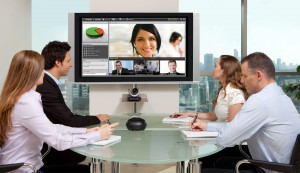 Introduction
Introduction
As the distinction between information and communication technology blurs, and the pressure to cut costs increases, video-conferencing is becoming more and more popular.
Co-workers are now able to participate in video- and tele- conferencing without making any special preparations or adding any new pieces of equipment to their desktop. This is a subtly new way of operating and it requires some thought about the etiquette that could be applied to ensure that this form of communication has credibility, trust and effectiveness. Much of the etiquette is similar to tele-conferencing.
Clothing
- Choose neutral and muted colours such as medium blues or pastels; they help the camera focus more easily
- Choose simple tailored clothing in solid dark colours, paired with a pale top
- Avoid very intense or bright colours – red may bleed on screen, white may glare, and black absorbs the light
- Avoid bold, complex or busy patterns like small checks or stripes – they can affect the camera’s ability to focus and may lower picture clarity
- Avoid all-light or all-dark clothing; they can trick the camera’s automatic brightness control
- Avoid fabric that shimmers and is iridescent or reflective; they can reflect the light
- Avoid bright, shiny jewellery such as bracelets and tie clasps; they can reflect the light
- Avoid large brooches or lots of ruffles; they can distract the eye
- Avoid hard charm bracelets, bangle bracelets, and long necklaces; they can be noisy
- Be aware that tinted glasses can make the eyes appear dark; this may make you appear untrustworthy
- Ensure the wall behind you is darker than you to avoid back lighting
Preparing
- Arrive at least fifteen minutes early to make sure the facility is fully functional, and that you are familiar with the operating procedures
- Turn off mobile phones; their signals may affect the conference audio and disrupt conversations; at least make the ring tone discrete
- Listen for any environmental noise such as fans, open windows or machinery that might reduce audio quality
Starting
- Start on time
- As you begin, ask the other sites if they can hear you and see you clearly; have them introduce themselves to be sure you can hear them and you know who is who
- Ensure that all people involved in the conference are aware of each other’s presence; each person at each venue should be introduced
Speaking
- Identify yourself when speaking for the first time
- When you are actively engaged in the conference, speak clearly; do not cover your mouth, or eat or drink when speaking
- Use your normal voice, but note that it does help to speak more slowly especially if you have a strong accent
- Use your normal voice, but it does help to speak a little louder than normal if you are quietly spoken
- Check the speed & volume of your voice with your fellow video-conference participants
- Pause occasionally so others may comment or ask questions; because of the audio delay sometimes experienced, use a brief pause between speakers to assure the full audio signal has been transmitted
- Ensure all participants have the opportunity to fully participate; it is difficult enough to participate without being unengaged
- Immediately deal with any inappropriate or threatening language or behaviour
Listening
- Avoid interrupting other speakers; two people cannot speak at the same time; jot down points as you think of them for later in the conference
- Be mindful of cameras and microphones; be careful not to put papers or other objects on top of them
- Avoid coughing into microphones, drumming fingers, rustling papers, clicking pens or tapping on the table
Manners
- Keep body movements to a minimum; move and gesture in a fluid, natural way
- Avoid rapid or distracting movements like swaying, rocking, or pacing
- Avoid turning back and forth in your chair, wiggling your foot, or playing with your hair or jewellery
- Ensure that no part of the conference is recorded without the permission of all participants; each person must have the opportunity to withdraw before any recording starts
- Minimise the use of behaviours that may be construed as not open; avoid whispering, talking to people off-screen, running side conversations
- Eating might not be appropriate at all; just because you have morning tea doesn’t mean everybody else does
- Avoid putting conferences on hold; ensure all likely distractions are minimised; avoid using the “mute” or “blind” buttons
- If you are forced to drop out of the conversation, advise participants that you are dropping out, and advise participants if and when you return to the conference
When you’re ready to talk, we’re ready to listen – so contact the Hub!